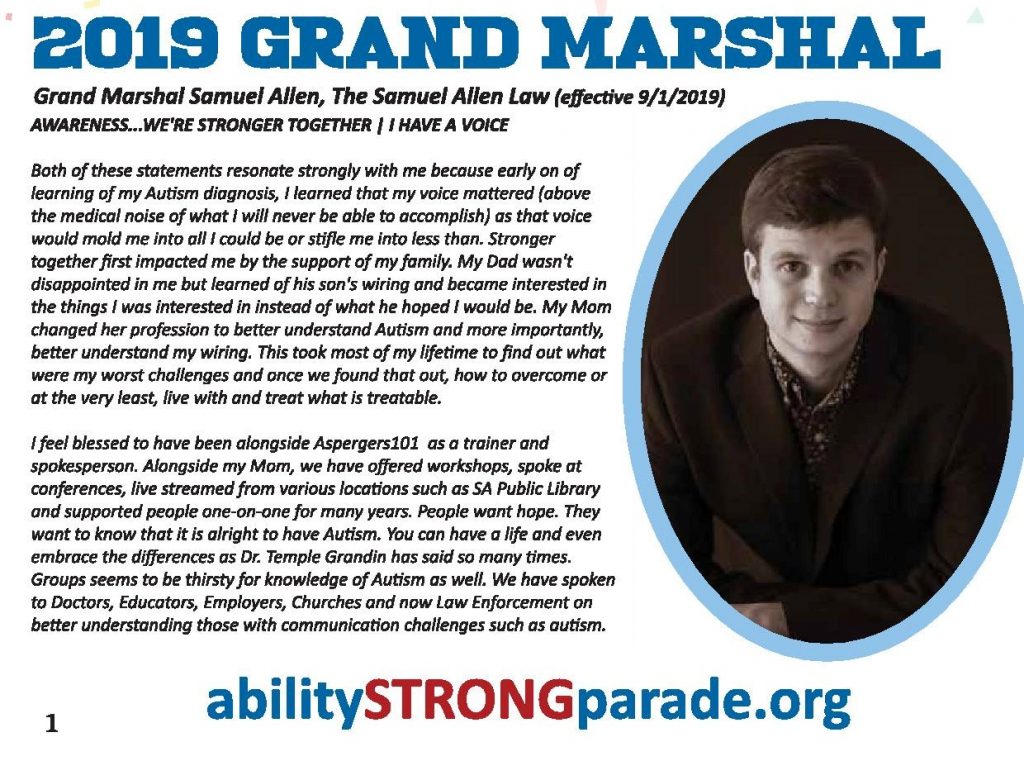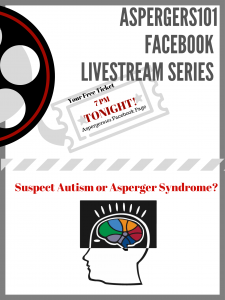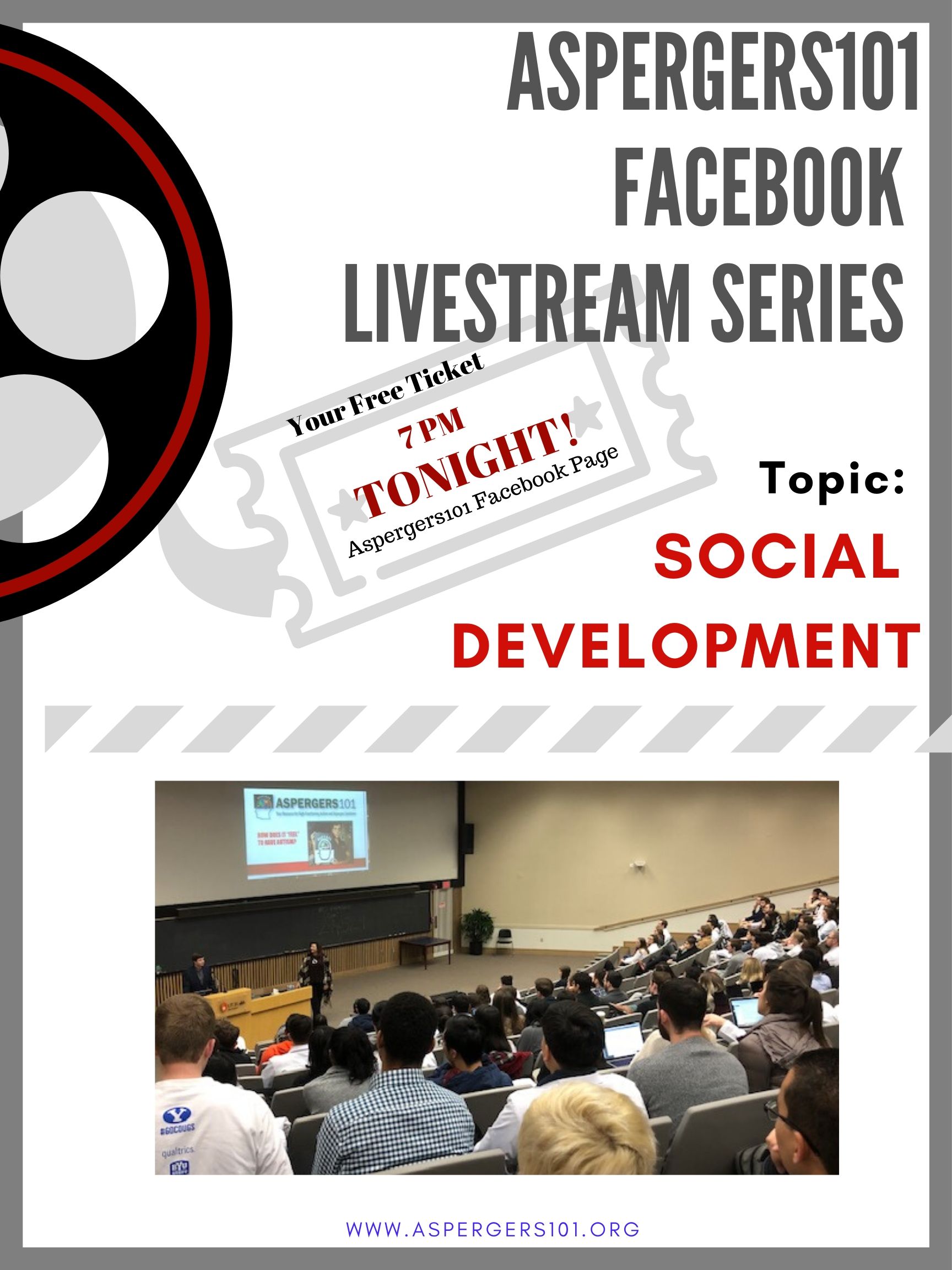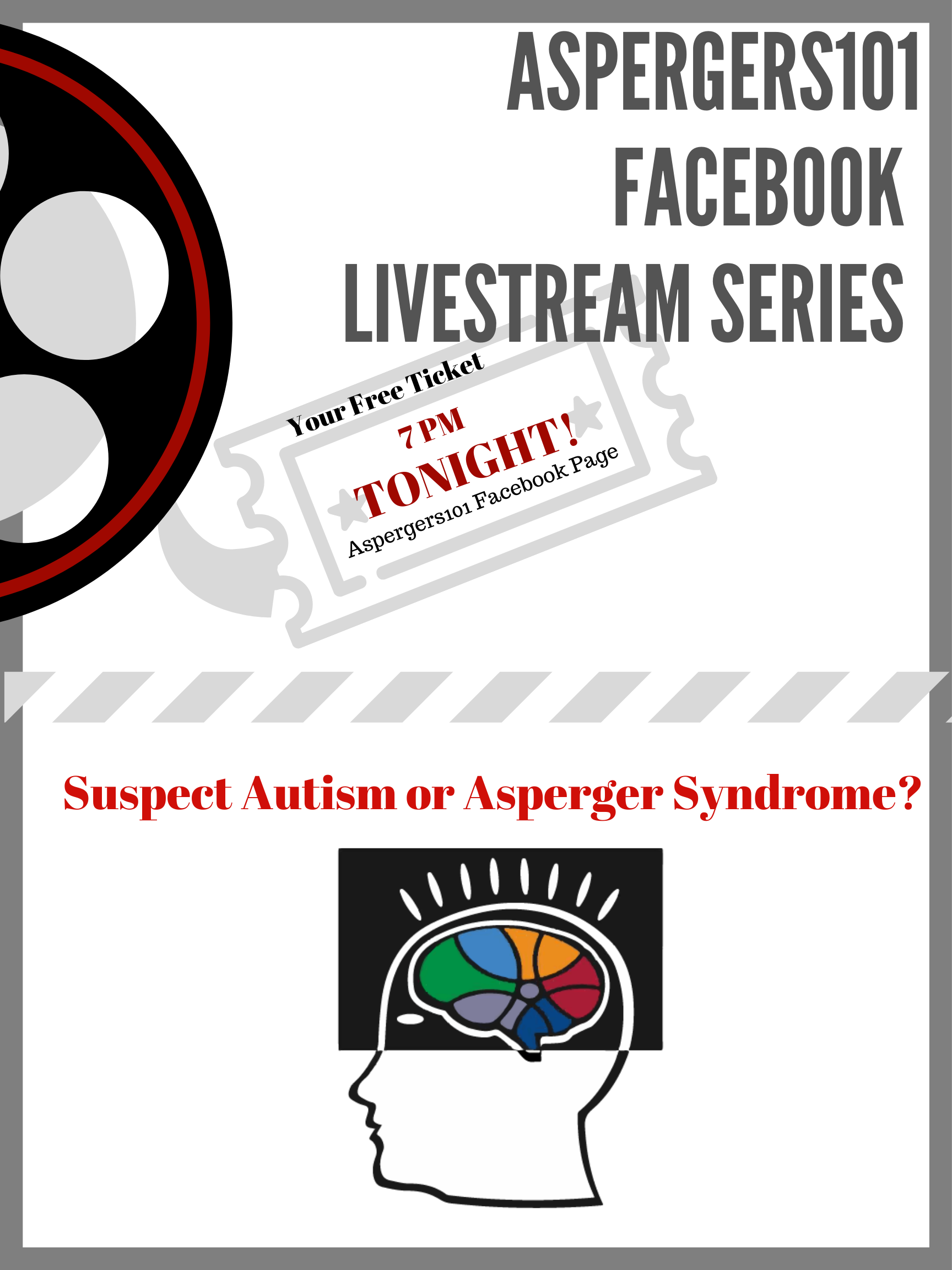Tonight! Social Development
Join Aspergers101 on Facebook for Livestream Series
There are many services available to help children with AS develop their skills and become more successful. Social skill groups, pragmatic speech and language therapy, occupational therapy, and special education services may all play a role in meeting the needs of your child. Guest speaker, Dr. Louise O’Donnell from UT Health Science Center, shares valuable insights into the autistic brain and offer solutions at every stage of a persons life when challenged with social integration. Host(s) Jennifer and Samuel Allen (Aspergers101) discuss effective strategies to teach social skills and address behavior are as varied and diverse as the unique individuals who make up the AS population and lead a panel of experts into the topic at programs end. (pre-recorded/runtime 1:31:00)

There are no fee(s) to join us…see you on Aspergers101 Facebook tonight at 7p! (CST)
Teen’s Inspiring Video Shows How He Overcame Autism Odds
Article by: Jennifer O’Neill (repost)
When Michael Whary was diagnosed with Autism as a child, doctors told his parents he wouldn’t be able to drive a car or even ride a bike.

“Well, they’re wrong,” now 16-year-old Michael declares — while two-wheeling, behind the wheel of a Hummer, and speed cruising around on an ATV— in an inspiring video he created as his community service project to become an Eagle Scout. The 13-minute film, titled “Autism Awareness,” has scored nearly 2,500 views on YouTube since it was posted in December. It’s also been featured in local news coverage in his hometown of Elyria, Ohio. What makes the high school sophomore’s film stand out, though, is that he addresses parents in the piece in an effort to “send them a message of hope,” he told WKYC.
An Autism diagnosis is “not your fault!” a slide introducing his footage proclaims to parents. “You are not alone!” Whary’s goal with the short film is to encourage parents to seek out early education opportunities for their children on the spectrum. Mom Judi Whary tells Yahoo Parenting her son, “knows how initially, diagnosis can be so devastating to the whole family. But the faster you get over the devastation and get to the education, the better.”
It worked for the teen, who takes viewers on a spirited walk through his old preschool, the Children’s Development Center in Amherst, Ohio, where he says he still goes to meet with his “social club.” As the tune of Katy Perry’s “Roar” blasts, teachers wave pom-poms, and kids hold up signs including “Autism is my Super Power.”
Happy Halloween!
Keeping it Safe
With all the spooky costumes, scary decorations, eerie noises, and sugary candy, Halloween can be a pretty overwhelming day and night for a child with autism.

The challenges that may arise for children with autism spectrum disorders (ASD) may seem obvious on the surface but if this is your first Halloween, there are some precautions you may take to keep the fear to a minimum and actually have some fun!
Halloween can be a great source of fun for kids, but there’s also no need to push it. Have your child join in, but only if she wants to. If any of the celebrations are not something you both enjoy, don’t feel obligated to participate.
Remember, the diagnosis of Autism does not mean your child cannot participate in Halloween, just take some extra time monitoring the stimuli.
Below are some pointers to make your Halloween a less stressful time for everyone.
- Let your child practice wearing their costume at home. This gives you time to make any last minute modifications and time for your child to get used to it. If your child refuses to wear any costume, consider letting them trick or treat in pajamas or regular clothing.
- Know your child’s limits and do only what he or she can handle. For example, if your child is not comfortable trick-or-treating, you can start by going to three houses. Assess how your child is doing and build up to more houses the following year.
- Create a visual schedule. This might include a map of where you will go.
- Practice trick or treating in a familiar environment. Visit friends and family, if possible, even neighbors.
- Partner with family and friends that your child likes. A sibling keeps them with the younger crowd but is familiar.
- Use role play to practice receiving and giving treats.
- If your child has difficulty with change, you may want to decorate your home gradually, especially with sensory issues. Be cognizant of over stimuli (bright flashing lights) and smells (candles).
- If you are giving out candy at your home, give your child the option to give a piece of candy. During the day, practice greeting people and giving out candy.
- If your child is afraid of going out at night, plan indoor or daytime Halloween activities.
- Remember, Halloween looks different for every child on the spectrum and you know your child best. Use your intuition and if you only make it to three houses, that’s okay!
Finally, be aware that Halloween celebrations may be LOUD and painful for those with sensory issues. Either bring headsets to buffer the sounds or remove your child from the heart of the noise. Preparation and planning can help you stay stress-free and keep Halloween a time of much fun instead of true horror!
Trick or Treat!?
5 Focuses For Creating a Learning Environment in the Home
When it comes to setting the stage for learning, individuals on the Autism Spectrum need to continue their learning experiences even after school. This requires responsibility from therapists, caregivers, and parents. Each must work together to help create a learning environment in the home that continues to provide opportunity to expand the vital skills a child is working on. This includes setting up a home environment, understanding your child’s classroom setup or making suggestions at their after school program.
Here are five goals to focus on when evaluating a school-related learning environment in the home for children with Aspergers or HFA.
1. Increase Engagement:
It’s ok for kids to take a break after school and have some down time, but preventing total shutout is important. Whether it is a play activity or helping with homework, making this part of the routine will assist with expectations that the child will need to interact for an expected amount of time.
2. Increase Communication:
Asking the question “how was your day?” rarely gets the response desired. To get them to chat, incorporate out of the ordinary or silly situations to spark spontaneous requests or comments. (e.g. carrying an umbrella when it isn’t raining or dressing up the dog before your child gets home). Sometimes a child may need a prompt to take note about the change in environment, but that is ok! It increases the opportunity to communicate either way
3. Promote Independence:
Use visual charts to show the steps expected to follow directions without reminders. This is especially useful for morning and bedtime routines. It may take some time to teach the sequence to complete the task. However, using the visual will allow the child to find the solution on their own rather than get in trouble for not completing the task.
Ode to the Special Needs Mom
This is an older post. One I wrote many years ago when my son, Samuel was very young. The alienation I felt then, has been replaced with an empathetic wisdom from life lived. Seems important not to forget those initial (relate-able) feelings as many of you are just beginning your journey with Autism. Know you are not alone and that the hope you have for your child, above all the noise, is what will be your child’s ultimate ‘therapy’ for living the best life possible!
Neurotypical Mom, as a Special Needs Mom your world is foreign to me. Rotating seasons of soccer, cool moms club, overnight parties, and college sororities comprise a universe outside my own. Church youth camps and activities that have the word “team” in them are daily reminders that I have a special needs child. Your child is included, mine is not. And I must find a way to turn these negatives into positives for the sake of my child’s future.
You see compassion instead of judgment; inclusion is actually put into practice instead of just being a buzz-word; and being a warrior for your child might be the strongest asset you women posses!

Raised competitive from a small town with sports and cheerleading in a world that didn’t include Autism makes it even more difficult to confess these surprising emotions. I’m not a whiner but what I want to do is shout “It’s not fair!” The only ones that hear or seem to want to understand this alien and painful feeling are what I’ve grown to refer to as special needs moms.Continue Reading
Sensory Overload at School: Insights From a Teacher
Sensory Overload at School
Guests: Malissa MacArthur
This edition of Top of The Spectrum News looks into the potential sensory overload at school that is often associated with Asperger’s Syndrome. A classroom teacher discusses how these issues may impede classroom performance.
Using Scripts to Develop Conversational Skills for Students with ASD
Actors use scripts to help them memorize dialogue as part of their performance. Once they have memorized the script, then they can recite the words from memory adding meaning through inflection, tone and pauses. One of the common strengths of students with an autism spectrum disorder is that of rote memorization.

Therefore, a script may be an excellent tool to build conversational skills. Scripts are written sentences or paragraphs that individuals can memorize and use as supports in social situations. From greetings to asking for help to engaging in a conversation, a script can be a simple and discrete visual support.
When possible, student interests may be incorporated to heighten motivation to use this strategy. If a student likes Harry Potter books, a script can incorporate pictures that represent events from that book that relate to the content of the script.
Scripts can also support students that tend to shift the conversation back to their own special interest.
San Antonio’s abilitySTRONG Parade…this Weekend!
Samuel Allen Grand Marshal
Everyone loves a parade! Especially when it’s the annual abilitySTRONG Parade, San Antonio’s inaugural Disability Pride Celebration. It is a public expression of the belief that disability is a natural and beautiful part of human diversity in which people living with disabilities can take pride. We have all your information of where to park, parade route and a list of all the activities slated to participate in beautiful downtown San Antonio!

The Parade Theme Awareness….We’re Stronger Together, resonates strongly with this year’s Grand Marshal Samuel Allen. “Upon hearing of my Autism diagnosis, I learned that my voice mattered above all the medical noise of what I will never be able to accomplish. That voice would mold me into all I could be or it would stifle me into less than.”
Event Checklist:

2nd Annual abilitySTRONG Parade
Saturday, October 26th, 2019
9:00 am – 10:00 am
Downtown, San Antonio
Parade Route: Avenue E & East Houston St. in front of First Presbyterian Church and Express News Bldg. South on Avenue E, West on Houston St. North on Flores St., West on Travis St., South on San Saba, East on Commerce St., South Pecos-La Trinidad and into the UTSA Cattleman Square parking lot.
Event Parking: Accessible shuttle services will be available between all of the lots below and Market Square from 7am – 2:30pm.UTSA D1 & D2 Lots
Employee A and B, and unmarked surface spaces.
*UTSA Geo Development Lot (On San Saba between Dolorosa & W. Nueva)
*Washington Square Lot (Santa Rosa & Nueva/Dolorosa)
*Washington Place Lot (Next to La Quinta on Dolorosa & South Santa Rosa)
*City Parking Lot (PAID PARKING Parking is available in the City Parking lot at Dolorosa between Santa Rosa and Laredo)
Event Program

Dr. Temple Grandin on Driving with Autism: Practice!
Though driving with an Autism diagnosis is not for everyone, many do decide to obtain their driver license and go on to live independent lives. Aspergers101 teamed with Dr. Temple Grandin to provide helpful information when considering if driving is for you, or your teen.
Long before driver education, Temple suggests first mastering your skills by practicing on a bicycle (coordination, motor skills). Then tackle driving in a safe remote area such as the country or large parking lot. You’ll begin mastering such challenging tasks, such as multi-tasking, prior to any driving on congested roadways.
One suggestion she has is that before you take a driver education course, you need to find a safe place and practice, and after that, practice even more! Getting the ‘knack’ of driving includes working on your coordination, motor skills, and multi-tasking which all come into play when learning to drive, even more so for those on the autism spectrum.
Anxiety can often be reduced (for the driver with Autism) by lots of driving practice in a safe remote location.
– Dr. Temple Grandin
Once you’ve mastered working the brake, blinker, gas and other essential tasks while driving, you’ll then be ready to be thrown into a group/driver education training.Continue Reading
Food and Picky Eaters with Asperger’s: Understanding, Involvement, and Support
Just like physical characteristics and personalities, we all have different taste palates. Are you a sweet-tooth person? Do you enjoy bitter or sour? Are spicy foods appetizing to you? Well, individuals diagnosed with Asperger’s have additional components that they factor in when deciding if they like a food or not.
They may have a texture component like crunchy or soft. What about a color component like only yellow foods or green foods? Food temperature can also help determine if they are willing to taste that food.
Due to the added components that have to line up before making a decision to taste a food item, the act of trying new foods can be an overwhelming event for someone with Asperger’s.
What can we do to help the process of trying and accepting new foods when working with someone with these difficulties? How can we place ourselves in their shoes and hopefully understand their view of new foods?
TONIGHT! Aspergers101 FB Livestreaming Series
Suspect Autism or Asperger Syndrome?
Tonight at 7pm (CST), we continue to offer you our year-end giving of information with the Aspergers101 Facebook Live-streaming Series! Tonight’s topic is one you might want to share with someone suspecting they, or their child, might have a form of Autism or Asperger Syndrome. It is as important to know one way or the other. Our guest speaker is Dr. Berenice de la Cruz, will she offers an overview and insight into the signs of autism. Additionally we will offer downloadables….there is no charge for admission! Just go to the Aspergers101 Facebook Page at 7pm (CST) tonight.

What: Suspect Autism or Asperger Syndrome?
Where: Aspergers101 Facebook Page
When: TONIGHT! 7p (CST) Monday October 21st
Why: Do you suspect someone you love has autism or Asperger Syndrome? This pre-recorded program explores the signs, the medical explanation, and the hardwired facts. Topics discussed will be the importance of diagnosis, grief, and moving forward with awareness. Hosted by Jennifer Allen & son Samuel Allen, Co-founders of Aspergers101. Special guest: Dr. Berenice de la Cruz, Ph.D., BCBA-D (runtime 1:31:18) Panel discussion follows.
Animal Shelter Volunteer Work for Kids and Teens with Autism: Master Social and Job Skills
Volunteering at an animal shelter is a great way for tweens, teens and young adults on the autism spectrum to practice and improve social and job skills. They also learn responsibility and a respect for animals. As visitors come into animal shelters to look at animals available for adoption, it’s the perfect place for teens to improve face-to-face communication. The experience they gain volunteering at an animal shelter molds them into more effective volunteers and prepares them for the workforce.
Volunteering at an animal shelter is a fantastic opportunity, especially for teens with Aspergers. It has been widely discussed that children, teens, and adults with Aspergers form strong bonds with pets, and can greatly benefit from animal companionship.
Their time spent volunteering will produce better outcomes (adoptions) if they have good communication skills. Here are some top social skills from my book to ensure teens maximize the chance of an animal getting adopted, and master important social and job skills:
1. Smile and Say Hello:
When you see another person, whether a co-volunteer, staff member or visitor, smile and say “Hello”. Your smile will set the tone for positive future interactions and brighten the person’s day. It may even lead to an animal getting adopted or a financial donation. It all starts with a smile!
I used to volunteer at an animal shelter walking dogs. Often I would be in the back of the shelter bringing a dog in or taking one out. There would be people in the back of the animal shelter looking for animals to possibly adopt. I would smile and say “Hello”. I’d ask if they had questions about any of the dogs I walked. Often they would. After telling them about the animals, I’d suggest they spend time with any animal they were interested in. About 70% of the time they’d end up adopting an animal just because I engaged them and was able to provide helpful information. You can do the same thing!
2. Turn Off the Electronics:
When you are volunteering, keep your phone at home, or turned off, on silent or vibrate mode, and out of sight. This is part of being a professional volunteer and lays the foundation for good work habits.








